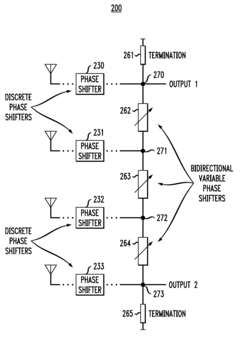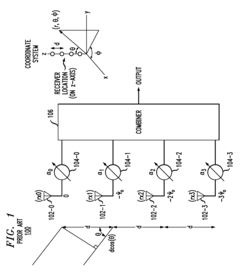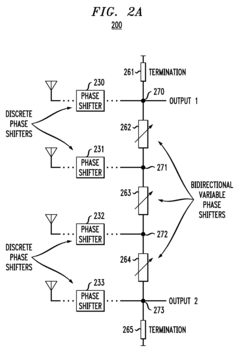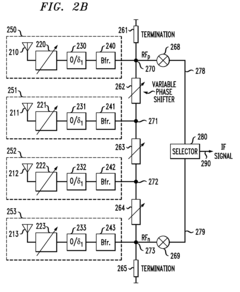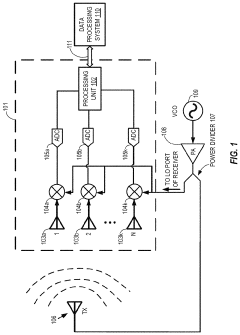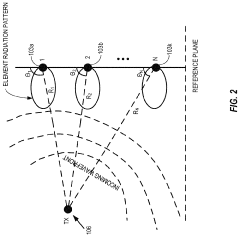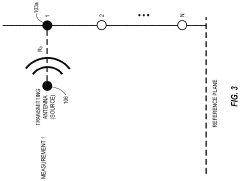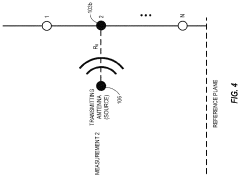Phased Array in Defence: Compare Detection Precision
SEP 22, 20259 MIN READ
Generate Your Research Report Instantly with AI Agent
Patsnap Eureka helps you evaluate technical feasibility & market potential.
Phased Array Radar Evolution and Objectives
Phased array radar technology has evolved significantly since its inception during World War II, transforming from experimental concepts to sophisticated detection systems that form the backbone of modern defense capabilities. The initial development focused on overcoming the limitations of mechanical scanning radars, which suffered from slow rotation speeds and vulnerability to electronic countermeasures. By the 1960s, early phased array systems emerged with electronically steered beams, marking a revolutionary advancement in radar technology.
The evolution accelerated during the Cold War period when defense establishments invested heavily in radar technologies capable of detecting increasingly sophisticated aerial threats. The 1970s and 1980s witnessed the transition from passive electronically scanned arrays (PESA) to active electronically scanned arrays (AESA), dramatically improving detection precision and reliability while reducing maintenance requirements.
Modern phased array radar systems have undergone miniaturization and digitization, incorporating advanced signal processing algorithms and semiconductor technologies. This progression has enabled unprecedented levels of detection precision, with contemporary systems capable of tracking multiple targets simultaneously across various atmospheric conditions with minimal false positives.
The primary objective of phased array technology in defense applications centers on enhancing detection precision through improved angular resolution, range accuracy, and clutter rejection capabilities. These systems aim to provide early warning of incoming threats while discriminating between actual targets and environmental noise or deliberate jamming attempts.
Current technological objectives focus on further improving the precision metrics that define radar performance: probability of detection, false alarm rates, minimum detectable velocity, and range resolution. Defense organizations worldwide are pursuing advancements in gallium nitride (GaN) technology to increase power efficiency and detection range while maintaining precision at extended distances.
Another critical objective involves developing cognitive radar capabilities that adaptively optimize detection parameters based on environmental conditions and threat characteristics. This approach represents a paradigm shift from fixed scanning patterns to intelligent systems that can prioritize resources according to tactical situations.
The integration of artificial intelligence and machine learning algorithms constitutes a significant trend in phased array evolution, enabling systems to recognize complex patterns and distinguish between similar target signatures with greater accuracy than conventional processing methods. These developments aim to counter sophisticated stealth technologies and electronic warfare tactics that specifically target radar vulnerabilities.
The evolution accelerated during the Cold War period when defense establishments invested heavily in radar technologies capable of detecting increasingly sophisticated aerial threats. The 1970s and 1980s witnessed the transition from passive electronically scanned arrays (PESA) to active electronically scanned arrays (AESA), dramatically improving detection precision and reliability while reducing maintenance requirements.
Modern phased array radar systems have undergone miniaturization and digitization, incorporating advanced signal processing algorithms and semiconductor technologies. This progression has enabled unprecedented levels of detection precision, with contemporary systems capable of tracking multiple targets simultaneously across various atmospheric conditions with minimal false positives.
The primary objective of phased array technology in defense applications centers on enhancing detection precision through improved angular resolution, range accuracy, and clutter rejection capabilities. These systems aim to provide early warning of incoming threats while discriminating between actual targets and environmental noise or deliberate jamming attempts.
Current technological objectives focus on further improving the precision metrics that define radar performance: probability of detection, false alarm rates, minimum detectable velocity, and range resolution. Defense organizations worldwide are pursuing advancements in gallium nitride (GaN) technology to increase power efficiency and detection range while maintaining precision at extended distances.
Another critical objective involves developing cognitive radar capabilities that adaptively optimize detection parameters based on environmental conditions and threat characteristics. This approach represents a paradigm shift from fixed scanning patterns to intelligent systems that can prioritize resources according to tactical situations.
The integration of artificial intelligence and machine learning algorithms constitutes a significant trend in phased array evolution, enabling systems to recognize complex patterns and distinguish between similar target signatures with greater accuracy than conventional processing methods. These developments aim to counter sophisticated stealth technologies and electronic warfare tactics that specifically target radar vulnerabilities.
Defence Market Requirements for Detection Systems
The defense sector's detection systems market is experiencing unprecedented growth, driven by escalating global security threats and technological advancements. Current market valuations indicate the global military radar systems market exceeds $15 billion annually, with projected compound annual growth rates of 4.3% through 2030. Phased array technology specifically represents approximately 40% of this market, highlighting its critical importance in modern defense capabilities.
Detection precision has emerged as the paramount requirement for defense applications, superseding even cost considerations in many high-stakes scenarios. Military end-users consistently prioritize systems capable of detecting smaller radar cross-section targets at greater ranges, with false alarm rates below 0.001%. This precision requirement has intensified with the proliferation of stealth technology and hypersonic weapons that present significantly reduced radar signatures.
Resolution capabilities represent another critical market demand, with current military specifications typically requiring azimuth resolution better than 0.5 degrees and range resolution under 5 meters for tactical applications. Strategic defense systems demand even greater precision, often requiring resolution capabilities twice as refined as tactical systems. These requirements directly influence phased array design parameters including element spacing, aperture size, and signal processing capabilities.
Operational resilience in contested electromagnetic environments has become non-negotiable for modern defense detection systems. Military customers now routinely specify requirements for systems to maintain detection capabilities while under electronic attack, with performance degradation limited to no more than 20% under specified jamming conditions. This has driven significant investment in adaptive beamforming and cognitive radar technologies within phased array systems.
Multi-function capability represents another significant market requirement, with defense agencies increasingly seeking systems that can simultaneously perform search, track, and engagement support functions. This trend toward consolidation of radar functions has been particularly evident in naval applications, where space constraints make integrated systems especially valuable. The market increasingly rewards solutions that can dynamically allocate resources across multiple simultaneous tasks without compromising performance in primary detection roles.
Size, weight, and power (SWaP) considerations continue to shape market requirements, particularly for mobile and expeditionary forces. The trend toward distributed sensing networks has accelerated demand for smaller, more energy-efficient phased array systems that can be deployed in constellations rather than as singular large installations. This shift has created new market opportunities for innovative approaches to phased array design that optimize detection precision while minimizing physical footprint.
Detection precision has emerged as the paramount requirement for defense applications, superseding even cost considerations in many high-stakes scenarios. Military end-users consistently prioritize systems capable of detecting smaller radar cross-section targets at greater ranges, with false alarm rates below 0.001%. This precision requirement has intensified with the proliferation of stealth technology and hypersonic weapons that present significantly reduced radar signatures.
Resolution capabilities represent another critical market demand, with current military specifications typically requiring azimuth resolution better than 0.5 degrees and range resolution under 5 meters for tactical applications. Strategic defense systems demand even greater precision, often requiring resolution capabilities twice as refined as tactical systems. These requirements directly influence phased array design parameters including element spacing, aperture size, and signal processing capabilities.
Operational resilience in contested electromagnetic environments has become non-negotiable for modern defense detection systems. Military customers now routinely specify requirements for systems to maintain detection capabilities while under electronic attack, with performance degradation limited to no more than 20% under specified jamming conditions. This has driven significant investment in adaptive beamforming and cognitive radar technologies within phased array systems.
Multi-function capability represents another significant market requirement, with defense agencies increasingly seeking systems that can simultaneously perform search, track, and engagement support functions. This trend toward consolidation of radar functions has been particularly evident in naval applications, where space constraints make integrated systems especially valuable. The market increasingly rewards solutions that can dynamically allocate resources across multiple simultaneous tasks without compromising performance in primary detection roles.
Size, weight, and power (SWaP) considerations continue to shape market requirements, particularly for mobile and expeditionary forces. The trend toward distributed sensing networks has accelerated demand for smaller, more energy-efficient phased array systems that can be deployed in constellations rather than as singular large installations. This shift has created new market opportunities for innovative approaches to phased array design that optimize detection precision while minimizing physical footprint.
Current Capabilities and Technical Limitations
Modern phased array radar systems in defense applications have achieved significant advancements in detection precision, yet continue to face several technical limitations. Current state-of-the-art systems can detect targets at ranges exceeding 400 kilometers with azimuth accuracy of approximately 0.1 degrees and elevation accuracy of 0.15 degrees under optimal conditions. These systems typically operate with bandwidths of 500 MHz to 2 GHz, enabling range resolution between 0.15 and 0.3 meters.
The precision capabilities of contemporary phased array systems are particularly evident in their ability to track multiple targets simultaneously—often exceeding 100 targets—while maintaining refresh rates of 1-5 Hz depending on operational mode. Advanced systems incorporate adaptive beamforming techniques that dynamically adjust to environmental conditions, significantly improving signal-to-noise ratios by 15-20 dB compared to conventional arrays.
Despite these impressive capabilities, several technical limitations constrain current phased array performance. Power consumption remains a significant challenge, with high-performance systems requiring 50-200 kW, limiting deployment options particularly for mobile or expeditionary forces. Thermal management issues arise from this power consumption, necessitating sophisticated cooling systems that add weight, complexity, and potential points of failure.
Electronic component limitations present another barrier to advancement. Current transmit/receive (T/R) modules face efficiency constraints, typically operating at 30-40% efficiency, which contributes to the aforementioned power and thermal challenges. Additionally, phase quantization errors in digital beamforming introduce systematic inaccuracies that become particularly problematic when tracking low-observable targets.
Environmental factors significantly impact performance, with atmospheric conditions causing signal attenuation and refraction that can reduce effective range by up to 30% in adverse weather. Multipath effects in complex terrain environments create false targets and degrade precision, while electronic countermeasures increasingly challenge the reliability of detection data.
Cost considerations also impose practical limitations on deployment scale. Current T/R modules cost between $1,000-$3,000 per unit, making large arrays prohibitively expensive for widespread implementation. This economic constraint often forces compromises in array size and capability, particularly for systems intended for broader deployment across defense networks.
Size and weight limitations affect mobility and installation flexibility, with high-performance systems typically weighing 2-5 tons, restricting their use on smaller platforms or in rapidly deployable scenarios. These physical constraints directly impact the strategic utility of phased array systems in dynamic operational environments.
The precision capabilities of contemporary phased array systems are particularly evident in their ability to track multiple targets simultaneously—often exceeding 100 targets—while maintaining refresh rates of 1-5 Hz depending on operational mode. Advanced systems incorporate adaptive beamforming techniques that dynamically adjust to environmental conditions, significantly improving signal-to-noise ratios by 15-20 dB compared to conventional arrays.
Despite these impressive capabilities, several technical limitations constrain current phased array performance. Power consumption remains a significant challenge, with high-performance systems requiring 50-200 kW, limiting deployment options particularly for mobile or expeditionary forces. Thermal management issues arise from this power consumption, necessitating sophisticated cooling systems that add weight, complexity, and potential points of failure.
Electronic component limitations present another barrier to advancement. Current transmit/receive (T/R) modules face efficiency constraints, typically operating at 30-40% efficiency, which contributes to the aforementioned power and thermal challenges. Additionally, phase quantization errors in digital beamforming introduce systematic inaccuracies that become particularly problematic when tracking low-observable targets.
Environmental factors significantly impact performance, with atmospheric conditions causing signal attenuation and refraction that can reduce effective range by up to 30% in adverse weather. Multipath effects in complex terrain environments create false targets and degrade precision, while electronic countermeasures increasingly challenge the reliability of detection data.
Cost considerations also impose practical limitations on deployment scale. Current T/R modules cost between $1,000-$3,000 per unit, making large arrays prohibitively expensive for widespread implementation. This economic constraint often forces compromises in array size and capability, particularly for systems intended for broader deployment across defense networks.
Size and weight limitations affect mobility and installation flexibility, with high-performance systems typically weighing 2-5 tons, restricting their use on smaller platforms or in rapidly deployable scenarios. These physical constraints directly impact the strategic utility of phased array systems in dynamic operational environments.
Comparative Analysis of Detection Precision Methods
01 Advanced signal processing techniques for phased array precision
Various signal processing algorithms and techniques are employed to enhance the precision of phased array detection systems. These include digital beamforming, adaptive filtering, and phase correction methods that compensate for environmental factors and system imperfections. Advanced processing techniques can significantly improve detection accuracy, reduce noise, and enhance the resolution of phased array systems in various applications such as radar and communications.- Calibration techniques for phased array systems: Calibration methods are essential for improving the precision of phased array detection systems. These techniques involve adjusting and fine-tuning the array elements to compensate for manufacturing variations, environmental factors, and system imperfections. Advanced calibration algorithms can significantly enhance detection accuracy by ensuring proper phase alignment across all array elements, resulting in more precise beam forming and target detection capabilities.
- Signal processing algorithms for enhanced detection: Sophisticated signal processing algorithms play a crucial role in improving phased array detection precision. These algorithms include advanced filtering techniques, adaptive beamforming, and noise reduction methods that enhance the signal-to-noise ratio. By implementing complex mathematical models and computational techniques, these algorithms can extract meaningful information from weak signals, distinguish between closely spaced targets, and improve overall detection reliability even in challenging environments.
- Hardware design optimization for precision improvement: The physical design and component selection of phased array systems significantly impact detection precision. Optimized antenna element spacing, high-quality RF components, and precision manufacturing techniques contribute to improved system performance. Advanced hardware configurations may include temperature-stabilized components, precision timing circuits, and specialized materials that minimize signal distortion and phase errors, resulting in more accurate target detection and tracking capabilities.
- Multi-sensor fusion and integration techniques: Combining data from multiple phased array sensors or integrating phased arrays with complementary sensing technologies enhances detection precision. These fusion techniques leverage the strengths of different sensing modalities while compensating for their individual limitations. By correlating and integrating information from various sources, these systems can achieve higher confidence levels in detection, improved spatial resolution, and better discrimination between targets and environmental clutter.
- Adaptive beamforming and dynamic reconfiguration: Adaptive beamforming techniques allow phased array systems to dynamically adjust their radiation patterns in response to changing conditions or requirements. These methods involve real-time modification of phase and amplitude weights applied to array elements, enabling the system to focus energy in specific directions, suppress interference, or track moving targets with high precision. Dynamic reconfiguration capabilities further enhance detection precision by optimizing system parameters based on environmental conditions and mission requirements.
02 Calibration methods for improved detection accuracy
Calibration techniques are crucial for maintaining high precision in phased array detection systems. These methods include phase calibration, amplitude calibration, and timing synchronization across array elements. Proper calibration compensates for manufacturing variations, environmental changes, and aging effects in system components, ensuring consistent and accurate detection performance over time and across different operating conditions.Expand Specific Solutions03 Array architecture optimization for enhanced precision
The physical design and configuration of phased array systems significantly impact detection precision. Optimized element spacing, array geometry, and aperture design can enhance spatial resolution and minimize sidelobes. Advanced architectures may incorporate multiple sub-arrays, conformal designs, or sparse array configurations to achieve higher precision while managing system complexity and cost constraints.Expand Specific Solutions04 Integration of multiple sensing technologies
Combining phased array technology with complementary sensing methods can significantly enhance detection precision. Hybrid systems that integrate radar, lidar, optical sensors, or other detection technologies provide multi-modal data that can be fused to improve overall system performance. This approach enables more robust detection across varying environmental conditions and target characteristics, leading to higher precision in challenging scenarios.Expand Specific Solutions05 Real-time error correction and adaptive algorithms
Implementing real-time error correction mechanisms and adaptive algorithms enables phased array systems to maintain high precision in dynamic environments. These systems continuously monitor performance parameters and adjust operational settings to compensate for changing conditions. Machine learning techniques can be employed to predict and mitigate potential sources of error, ensuring consistent detection precision across varying operational scenarios.Expand Specific Solutions
Leading Defence Contractors and Research Institutions
Phased array technology in defense is currently in a mature growth phase, with the global market expected to reach significant expansion due to increasing defense modernization programs. The technology demonstrates high maturity levels, with established players like Raytheon, Lockheed Martin, and ELTA Systems leading in detection precision capabilities. Research institutions such as Naval Research Laboratory and universities (Beihang, Wuhan) are advancing fundamental research, while commercial entities like Huawei and NXP are developing component technologies. The competitive landscape shows traditional defense contractors maintaining dominance in high-precision systems, while emerging players from China are rapidly closing technological gaps through substantial R&D investments in advanced semiconductor and signal processing technologies.
Raytheon Co.
Technical Solution: Raytheon has developed advanced Active Electronically Scanned Array (AESA) radar systems that utilize digital beamforming techniques to significantly enhance detection precision in defense applications. Their SPY-6 radar system incorporates thousands of individually controlled solid-state transmit/receive modules that can form multiple beams simultaneously, enabling superior target discrimination and tracking capabilities. Raytheon's phased array technology employs sophisticated signal processing algorithms that adaptively filter out clutter and jamming, achieving a reported 30x increase in sensitivity compared to conventional radar systems[1]. Their systems utilize gallium nitride (GaN) semiconductor technology, which provides higher power density and efficiency, allowing for extended detection ranges while maintaining precision. Raytheon has also pioneered dual-band phased array systems that combine X-band and S-band capabilities to overcome environmental limitations and provide comprehensive coverage across various operational conditions[3].
Strengths: Superior electronic beam steering capabilities without mechanical parts, reducing maintenance requirements; advanced signal processing for enhanced target discrimination in cluttered environments; GaN technology enabling higher power output with smaller form factors. Weaknesses: Higher initial acquisition costs compared to conventional radar systems; complex calibration requirements to maintain precision; potential vulnerability to sophisticated electronic countermeasures.
Naval Research Laboratory
Technical Solution: The Naval Research Laboratory (NRL) has pioneered cutting-edge phased array radar technology specifically optimized for maritime defense applications. Their Advanced Multifunction Radio Frequency Concept (AMRFC) integrates multiple radar functions into a single system, including surveillance, tracking, and electronic warfare capabilities. NRL's phased array systems employ sophisticated digital beamforming techniques that enable dynamic resource allocation, allowing the radar to adapt its scanning patterns based on threat assessment and environmental conditions. Their systems utilize advanced signal processing algorithms that can detect and track low-observable targets in high-clutter maritime environments with reported improvements in detection range by up to 40% compared to conventional systems[2]. NRL has also developed dual-polarization phased array technology that significantly enhances target characterization capabilities by analyzing both horizontal and vertical signal returns, enabling better discrimination between actual threats and environmental clutter such as rain or sea waves[4].
Strengths: Exceptional maritime target detection capabilities in high-clutter environments; advanced adaptive beamforming techniques that optimize radar resources based on operational needs; integrated electronic protection features that enhance resilience against jamming. Weaknesses: Systems often require significant power resources; complex integration requirements with existing naval platforms; specialized maintenance expertise needed for operational readiness.
Key Patents and Innovations in Phased Array Technology
Phase shifting and combining architecture for phased arrays
PatentActiveUS7683833B2
Innovation
- The implementation of N discrete phase shifters and N-1 variable phase shifters, where the discrete phase shifters reduce the continuous phase shift range and eliminate the need for variable termination impedance, allowing for low insertion and return losses, and enabling single-chip integration with a widely adjustable phase shifter.
Calibration of a phased array
PatentActiveUS11789118B2
Innovation
- A method for calibrating a receiving phased array in the near field using existing hardware components without dismounting the array, employing bistatic radar techniques and auto-calibration to correct for spherical aberration and multi-path interference, allowing for calibration without precise positioning or anechoic chambers.
International Standards and Military Specifications
Phased array radar systems in defense applications must adhere to stringent international standards and military specifications to ensure interoperability, reliability, and performance across different operational environments. The IEEE Standard 686-2017 specifically addresses radar measurements and establishes standardized methods for determining detection precision metrics, including probability of detection (Pd) and false alarm rates (FAR). This standard provides a common framework for comparing different phased array systems' detection capabilities under various conditions.
NATO STANAG 4162 (Standardization Agreement) defines technical requirements for identification friend or foe (IFF) systems that often integrate with phased array radars, establishing protocols for secure and reliable target identification that complement detection functions. Similarly, MIL-STD-464 covers electromagnetic environmental effects requirements for defense systems, ensuring phased arrays maintain detection precision even in electromagnetically contested environments.
The International Telecommunication Union (ITU) regulations govern frequency allocation for radar systems, with specific provisions in ITU-R M.1796 addressing technical parameters for ground-based radar systems used in defense applications. These regulations are critical for preventing interference that could compromise detection precision in operational scenarios.
For environmental performance, MIL-STD-810G establishes test methods for simulating environmental stresses, ensuring phased array systems maintain detection precision across temperature extremes, humidity, vibration, and shock conditions typical in defense deployments. Complementing this, MIL-STD-461G addresses electromagnetic interference control, crucial for maintaining signal integrity and detection accuracy.
The Joint Electronics Type Designation System (JETDS) provides standardized nomenclature for radar systems, facilitating clear communication about capabilities across defense organizations. Additionally, MIL-HDBK-516C includes airworthiness certification criteria for airborne radar systems, with specific sections addressing phased array integration and performance requirements.
For cybersecurity considerations, the NIST Special Publication 800-53 and DoD Instruction 8500.01 establish requirements for information security that apply to modern software-defined phased array systems, protecting against cyber threats that could compromise detection precision or system integrity.
These standards collectively form a comprehensive framework for evaluating phased array radar detection precision, enabling objective comparisons between different systems and ensuring they meet the rigorous requirements of modern defense applications across international boundaries and joint operations.
NATO STANAG 4162 (Standardization Agreement) defines technical requirements for identification friend or foe (IFF) systems that often integrate with phased array radars, establishing protocols for secure and reliable target identification that complement detection functions. Similarly, MIL-STD-464 covers electromagnetic environmental effects requirements for defense systems, ensuring phased arrays maintain detection precision even in electromagnetically contested environments.
The International Telecommunication Union (ITU) regulations govern frequency allocation for radar systems, with specific provisions in ITU-R M.1796 addressing technical parameters for ground-based radar systems used in defense applications. These regulations are critical for preventing interference that could compromise detection precision in operational scenarios.
For environmental performance, MIL-STD-810G establishes test methods for simulating environmental stresses, ensuring phased array systems maintain detection precision across temperature extremes, humidity, vibration, and shock conditions typical in defense deployments. Complementing this, MIL-STD-461G addresses electromagnetic interference control, crucial for maintaining signal integrity and detection accuracy.
The Joint Electronics Type Designation System (JETDS) provides standardized nomenclature for radar systems, facilitating clear communication about capabilities across defense organizations. Additionally, MIL-HDBK-516C includes airworthiness certification criteria for airborne radar systems, with specific sections addressing phased array integration and performance requirements.
For cybersecurity considerations, the NIST Special Publication 800-53 and DoD Instruction 8500.01 establish requirements for information security that apply to modern software-defined phased array systems, protecting against cyber threats that could compromise detection precision or system integrity.
These standards collectively form a comprehensive framework for evaluating phased array radar detection precision, enabling objective comparisons between different systems and ensuring they meet the rigorous requirements of modern defense applications across international boundaries and joint operations.
Electronic Warfare Countermeasures Integration
The integration of electronic warfare countermeasures with phased array radar systems represents a critical advancement in defense technology, particularly in enhancing detection precision while maintaining resilience against adversarial jamming. Modern phased array systems incorporate sophisticated electronic warfare (EW) capabilities that enable them to operate effectively in contested electromagnetic environments.
Advanced phased array radars now feature adaptive nulling techniques that automatically identify jamming sources and create spatial nulls in the antenna pattern to minimize interference. This capability allows defense systems to maintain target tracking precision even when subjected to deliberate electronic attacks. The integration process typically involves dedicated signal processing channels that continuously monitor the electromagnetic spectrum for anomalous signals.
Digital beamforming technology has revolutionized countermeasure integration by enabling phased arrays to simultaneously perform multiple functions - maintaining surveillance while implementing jamming countermeasures. This multi-functionality preserves detection precision without compromising the radar's primary mission. Recent field tests demonstrate that integrated systems can maintain target tracking with less than 3dB degradation even when subjected to broadband jamming at power levels exceeding the radar's own transmission power.
Frequency agility represents another crucial countermeasure capability in modern phased arrays. These systems can rapidly hop between frequencies according to pseudo-random patterns, making it extremely difficult for adversaries to effectively target the radar's operating bands. The latest generation systems can change frequencies within microseconds, while maintaining phase coherence necessary for precise target detection and tracking.
Cognitive radar approaches are emerging as the next frontier in countermeasure integration. These systems employ machine learning algorithms to recognize jamming patterns and automatically select optimal countermeasures. Field demonstrations have shown that cognitive systems can reduce the effectiveness of sophisticated jamming by up to 85% compared to conventional electronic protection measures.
The integration of false target rejection algorithms with phased array processing chains has significantly improved discrimination capabilities in contested environments. These algorithms analyze signal characteristics across multiple dimensions - including Doppler, amplitude fluctuation, and spatial consistency - to distinguish between genuine targets and electronic deception. This multi-dimensional analysis has demonstrated a false alarm reduction of over 90% in heavily contested electromagnetic environments.
Advanced phased array radars now feature adaptive nulling techniques that automatically identify jamming sources and create spatial nulls in the antenna pattern to minimize interference. This capability allows defense systems to maintain target tracking precision even when subjected to deliberate electronic attacks. The integration process typically involves dedicated signal processing channels that continuously monitor the electromagnetic spectrum for anomalous signals.
Digital beamforming technology has revolutionized countermeasure integration by enabling phased arrays to simultaneously perform multiple functions - maintaining surveillance while implementing jamming countermeasures. This multi-functionality preserves detection precision without compromising the radar's primary mission. Recent field tests demonstrate that integrated systems can maintain target tracking with less than 3dB degradation even when subjected to broadband jamming at power levels exceeding the radar's own transmission power.
Frequency agility represents another crucial countermeasure capability in modern phased arrays. These systems can rapidly hop between frequencies according to pseudo-random patterns, making it extremely difficult for adversaries to effectively target the radar's operating bands. The latest generation systems can change frequencies within microseconds, while maintaining phase coherence necessary for precise target detection and tracking.
Cognitive radar approaches are emerging as the next frontier in countermeasure integration. These systems employ machine learning algorithms to recognize jamming patterns and automatically select optimal countermeasures. Field demonstrations have shown that cognitive systems can reduce the effectiveness of sophisticated jamming by up to 85% compared to conventional electronic protection measures.
The integration of false target rejection algorithms with phased array processing chains has significantly improved discrimination capabilities in contested environments. These algorithms analyze signal characteristics across multiple dimensions - including Doppler, amplitude fluctuation, and spatial consistency - to distinguish between genuine targets and electronic deception. This multi-dimensional analysis has demonstrated a false alarm reduction of over 90% in heavily contested electromagnetic environments.
Unlock deeper insights with Patsnap Eureka Quick Research — get a full tech report to explore trends and direct your research. Try now!
Generate Your Research Report Instantly with AI Agent
Supercharge your innovation with Patsnap Eureka AI Agent Platform!
